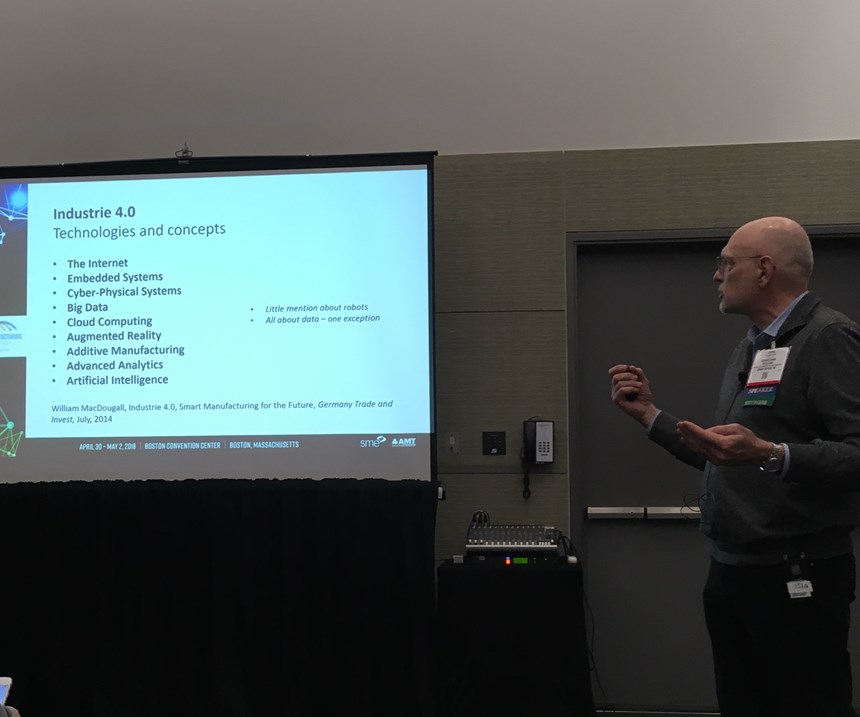10 Takeaways about the Industrial Internet of Things
What will it look like for manufacturing to embrace and make use of interconnected hardware? Here are some clues.
Share





Conceptually, what is meant by the "Internet of Things" (IoT) is clear. Objects can interact with one another to drive automatic decision-making the same way that apps, websites and other information tools interact now. The Industrial Internet of Things (IIoT) is this idea applied to manufacturing. What this will mean in practical terms, what it will really mean for manufacturers, is harder to grasp—but I am starting to get it.
At two recent conferences, the Smart Manufacturing Experience and the FT Future of Manufacturing Summit, manufacturers just beginning to succeed with the IIoT shared their experiences. From these accounts, I drew 10 takeaways about the industrial use and value of the Internet of Things:
1. Malware is a major concern. Security has to be step one. Otherwise, interconnecting machines creates the risk of malicious code causing an epidemic.
2. Everyday objects become smart. For furniture maker Steelcase, the IIoT instructs production staff. For example, a power screwdriver outfitted with sensors means torque is monitored and the operator is alerted when the optimum number of turns is met.
3. Everyday inefficiencies become clear. For this same manufacturer, data showed one manufacturing step took 20 percent longer for one style of a particular part compared to parts that are otherwise identical. The reason is that this particular style fits tighter in its fixture and the hardware needed to work on this style sits just slightly farther from the operator’s reach. Every operator knew that this particular style was “the hard one,” but the IIoT quantified the effect and made it plain.
4. IIoT guides kaizen. The proven means of looking for process improvements still happen, but now data directs the search.
5. Tools are free. Azure, IFTTT, Amazon Web Service IoT: just of few of the tools or tool kits for programming how a physical event produces a response, all free.
6. No special distinction for robots. The IoT is automation, but not as we commonly imagine it. Robots are no more and no less appropriate to IoT than other devices.
7. Additive manufacturing (AM) and IoT connect. Because AM enables direct digital part making without intervening steps for setup or tooling, AM is an enabler for IoT-driven production.
8. The "things" include people. The Digital Capability Center in Chicago, Illinois, shows a striking example of this point. Motion sensors (think Xbox) monitor the work of assembly employees to gather data and even alert them when they make the wrong move.
9. The payoff is productivity. To account for why it had embraced IoT, Rhode Island manufacturer Vibco explained that only by mapping and mastering its process using data will the company be able to improve its efficiency enough to meet leadtime goals.
10. Transformative progress is the promise. At the FT summit, Patrick Bass, CEO of Thyssenkrupp North America, described the path he has seen for advancing with the IIoT. First comes digitization, or capturing the data. Then comes digitalization: using it. The third step, the goal, is the digital transformation.
Related Content
-
Can Connecting ERP to Machine Tool Monitoring Address the Workforce Challenge?
It can if RFID tags are added. Here is how this startup sees a local Internet of Things aiding CNC machine shops.
-
Protecting Your Automation Investments
Shops need to look at their people, processes and technology to get the most of out their automation systems.
-
Machine Monitoring Boosts Aerospace Manufacturer's Utilization
Once it had a bird’s eye view of various data points across its shops, this aerospace manufacturer raised its utilization by 27% in nine months.






















.jpg;maxWidth=300;quality=90)




